Experimental Validation of Predictive Current Control for DFIG: FPGA Implementation
Abstract
1. Introduction
2. Topology Description and Modeling
3. Design of Predictive Current Control
3.1. Field Orientation Strategy
3.2. Discrete-Time Presentation
3.3. Predictive Current Control
4. TESTBENCH Description
4.1. Wind Emulator
4.2. FPGA Implementation of Predictive Current Control
5. Results and Discussions
6. Conclusions
Author Contributions
Funding
Acknowledgments
Conflicts of Interest
References
- Aroussi, H.A.; Ziani, E.; Bouderbala, M.; Bossoufi, B. Improvement of direct torque control applied to doubly fed induction motor under variable speed. Int. J. Power Electron. Drive Syst. (IJPEDS) 2020, 11, 97–106. [Google Scholar] [CrossRef]
- Abad, G.; Lopez, J.; Rodríguez, M.; Marroyo, L.; Iwanski, G. Doubly Fed Induction Machine: Modeling and Control for wInd Energy Generation; John Wiley & Sons: Hoboken, NJ, USA, 2011. [Google Scholar]
- Hannan, M.; Lipu, M.H.; Ker, P.J.; Begum, R.; Agelidis, V.G.; Blaabjerg, F. Power electronics contribution to renewable energy conversion addressing emission reduction: Applications, issues, and recommendations. Appl. Energy 2019, 251, 113404. [Google Scholar] [CrossRef]
- Tarisciotti, L.; Calzo, G.L.; Gaeta, A.; Zanchetta, P.; Valencia, F.; Saez, D. A Distributed Model Predictive Control Strategy for Back-to-Back Converters. IEEE Trans. Ind. Electron. 2016, 63, 5867–5878. [Google Scholar] [CrossRef]
- Yang, X.; Liu, G.; Li, A.; Van Dai, L. A Predictive Power Control Strategy for DFIGs Based on a Wind Energy Converter System. Energies 2017, 10, 1098. [Google Scholar] [CrossRef]
- Bouderbala, M.; Bossoufi, B.; Aroussi, H.A.; Lagrioui, A.; Taoussi, M.; Ihedrane, Y.; El Ghamrasni, M. Modeling and Power Controls of Wind Energy Conversion Systems Based on Doubly Fed Induction Generator. In Proceedings of the 6th International Sustainable Energy Conference—ISEC 2018, Graz, Austria, 3–5 October 2018. [Google Scholar] [CrossRef]
- Bouchiba, N.; Barkia, A.; Sallem, S.; Alaoui, L.C.; Drid, S.; Kammoun, M.B.A. Implementation and comparative study of control strategies for an isolated DFIG based WECS. Eur. Phys. J. Plus 2017, 132, 415. [Google Scholar] [CrossRef]
- Prasad, R.M.; Mulla, M.A. Mathematical Modeling and Position-Sensorless Algorithm for Stator-Side Field-Oriented Control of Rotor-Tied DFIG in Rotor Flux Reference Frame. IEEE Trans. Energy Convers. 2019, 35, 631–639. [Google Scholar] [CrossRef]
- Nahilia, H.; Boudour, M.; Cardenas, A.; Agbossou, K.; Doumbia, M.L. Doubly fed induction wind generators model and field orientation vector control design and implementation on FPGA. Int. J. Dyn. Control. 2019, 7, 1005–1014. [Google Scholar] [CrossRef]
- Naik, K.A.; Gupta, C.P.; Fernandez, E. Design and implementation of interval type-2 fuzzy logic-PI based adaptive controller for DFIG based wind energy system. Int. J. Electr. Power Energy Syst. 2019, 115, 105468. [Google Scholar] [CrossRef]
- Marugán, A.P.; Márquez, F.P.G.; Perez, J.M.P.; Ruiz-Hernández, D. A survey of artificial neural network in wind energy systems. Appl. Energy 2018, 228, 1822–1836. [Google Scholar] [CrossRef]
- Hamasaki, S.-I.; Takaki, T.; Miyazaki, S.; Tsuji, M. Experimental verification of deadbeat control for unified power flow controller. In Proceedings of the 41st Annual Conference of the IEEE Industrial Electronics Society, Yokohama, Japan, 9–12 November 2015. [Google Scholar] [CrossRef]
- Beyene, A.M.; Haile, E.A.; Worku, G.B.; Tuka, M.B. Modeling of doubly fed induction generator based wind energy conversion system and speed controller. J. Energy Syst. 2021, 5, 46–59. [Google Scholar] [CrossRef]
- Dbaghi, Y.; Farhat, S.; Mediouni, M.; Essakhi, H.; Elmoudden, A. Indirect power control of DFIG based on wind turbine operating in MPPT using backstepping approach. Int. J. Electr. Comput. Eng. (IJECE) 2021, 11, 1951–1961. [Google Scholar] [CrossRef]
- Bouchiba, N.; Keskes, S.; Sallem, S.; Alaoui, L.C.; Drid, S.; Kammoun, M. Experimental control of a Doubly Fed Induction Generator based Wind Energy Conversion System. In Proceedings of the 2018 7th International Conference on Systems and Control (ICSC), Valencia, Spain, 24–26 October 2018; pp. 142–147. [Google Scholar] [CrossRef]
- Bossoufi, B.; Karim, M.; Taoussi, M.; Alami-Aroussi, H.; Bouderbala, M.; Deblecker, O.; Motahhir, S.; Nayyar, A.; AlZain, M.A. Rooted Tree Optimization for the Backstepping Power Control of a Doubly Fed Induction Generator Wind Turbine: dSPACE Implementation. IEEE Access 2021, 9, 26512–26522. [Google Scholar] [CrossRef]
- Boubzizi, S.; Abid, H.; El Hajjaji, A.; Chaabane, M. Comparative study of three types of controllers for DFIG in wind energy conversion system. Prot. Control. Mod. Power Syst. 2018, 3, 21. [Google Scholar] [CrossRef]
- Yang, L.; Liu, T.; Hill, D.J. Distributed MPC-based frequency control for multi-area power systems with energy storage. Electr. Power Syst. Res. 2020, 190, 106642. [Google Scholar] [CrossRef]
- Zhou, D.; Blaabjerg, F. Bandwidth oriented proportional-integral controller design for back-to-back power converters in DFIG wind turbine system. IET Renew. Power Gener. 2017, 11, 941–951. [Google Scholar] [CrossRef]
- Mazouz, F.; Belkacem, S.; Colak, I.; Drid, S.; Harbouche, Y. Adaptive direct power control for double fed induction generator used in wind turbine. Int. J. Electr. Power Energy Syst. 2019, 114, 105395. [Google Scholar] [CrossRef]
- Bossoufi, B.; Aroussi, H.A.; Boderbala, M. Direct Power Control of Wind Power Systems based on DFIG-Generator (WECS). In Proceedings of the 2020 12th International Conference on Electronics, Computers and Artificial Intelligence (ECAI), Bucharest, Romania, 25–27 June 2020. [Google Scholar] [CrossRef]
- Yaramasu, V.; Wu, B. Model Predictive Control of Wind Energy Conversion Systems; IEEE: Hoboken, NJ, USA, 2017. [Google Scholar]
- Vazquez, S.; Leon, J.I.; Franquelo, L.G.; Rodriguez, J.; Young, H.; Marquez, A.; Zanchetta, P. Model Predictive Control: A Review of Its Applications in Power Electronics. IEEE Ind. Electron. Mag. 2014, 8, 16–31. [Google Scholar] [CrossRef]
- Segovia, P.; Puig, V.; Duviella, E.; Etienne, L. Distributed model predictive control using optimality condition decomposition and community detection. J. Process. Control 2021, 99, 54–68. [Google Scholar] [CrossRef]
- Bossoufi, B.; Karim, M.; Taoussi, M.; Aroussi, H.A.; Bouderbala, M.; Motahhir, S.; Camara, M.B. DSPACE-based implementation for observer backstepping power control of DFIG wind turbine. IET Electr. Power Appl. 2020, 14, 2395–2403. [Google Scholar] [CrossRef]
- Jain, B.; Jain, S.; Nema, R. Control strategies of grid interfaced wind energy conversion system: An overview. Renew. Sustain. Energy Rev. 2015, 47, 983–996. [Google Scholar] [CrossRef]
- Alaboudy, A.K.; Daoud, A.A.; Desouky, S.S.; Salem, A.A. Converter controls and flicker study of PMSG-based grid connected wind turbines. Ain Shams Eng. J. 2013, 4, 75–91. [Google Scholar] [CrossRef]
- Charabi, Y.; Abdul-Wahab, S. Wind turbine performance analysis for energy cost minimization. Renew. Wind. Water Sol. 2020, 7, 5. [Google Scholar] [CrossRef]
- Hala, A.A.; Ziani, E.M.; Manale, B.; Badre, B. DPC & DNPC Applied To Wind Energy Converter System. In Proceedings of the 2020 5th International Conference on Renewable Energies for Developing Countries (REDEC), Marrakech, Morocco, 24–26 March 2020. [Google Scholar]
- Manale, B.; Badre, B.; Hala, A.A.; Mohammed, T.; Ahmed, L.; Petru, L. DEADBEAT Control Applied toWind Power System. In Proceedings of the 2020 5th International Conference on Renewable Energies for Developing Countries (REDEC), Marrakech, Morocco, 24–26 March 2020. [Google Scholar]
- Filho, A.J.S.; Ruppert, E. Modeling and Designing a Deadbeat Power Control for Doubly-Fed Induction Generator. Wind. Energy Manag. 2011, 113–128. [Google Scholar] [CrossRef][Green Version]
- Gholami-Khesht, H.; Monfared, M. Deadbeat direct power control for grid connected inverters using a full-order observer. In Proceedings of the 2015 4th International Conference on Electric Power and Energy Conversion Systems (EPECS), Sharjah, United Arab Emirates, 24–26 November 2015. [Google Scholar] [CrossRef]
- Franco, R.; Capovilla, C.; Jacomini, R.V.; Altana, J.A.T.; Filho, A.J.S. A deadbeat direct power control applied to doubly-fed induction aerogenerator under normal and sag voltages conditions. In Proceedings of the IECON 2014 40th Annual Conference of the IEEE Industrial Electronics Society, Dallas, TX, USA, 29 October–1 November 2014. [Google Scholar] [CrossRef]
- Bonny, T. Chaotic or Hyper-chaotic Oscillator? Numerical Solution, Circuit Design, MATLAB HDL-Coder Implementation, VHDL Code, Security Analysis, and FPGA Realization. Circuits Syst. Signal Process. 2020, 40, 1061–1088. [Google Scholar] [CrossRef]
- Naik, R.L.; Ieee, M. FPGA Based Implementation of Symmetrical Switching in SVPWM for Three Level NPC Converter. In Proceedings of the 3rd International Conference on Inventive Systems and Control (ICISC 2019), Coimbatore, India, 10–11 January 2019; pp. 592–597. [Google Scholar]
- Moussa, I.; Bouallegue, A.; Khedher, A. 3 kW wind turbine emulator implementation on FPGA using matlab/simulink. Architecture 2015, 5, 1154–1163. [Google Scholar] [CrossRef]

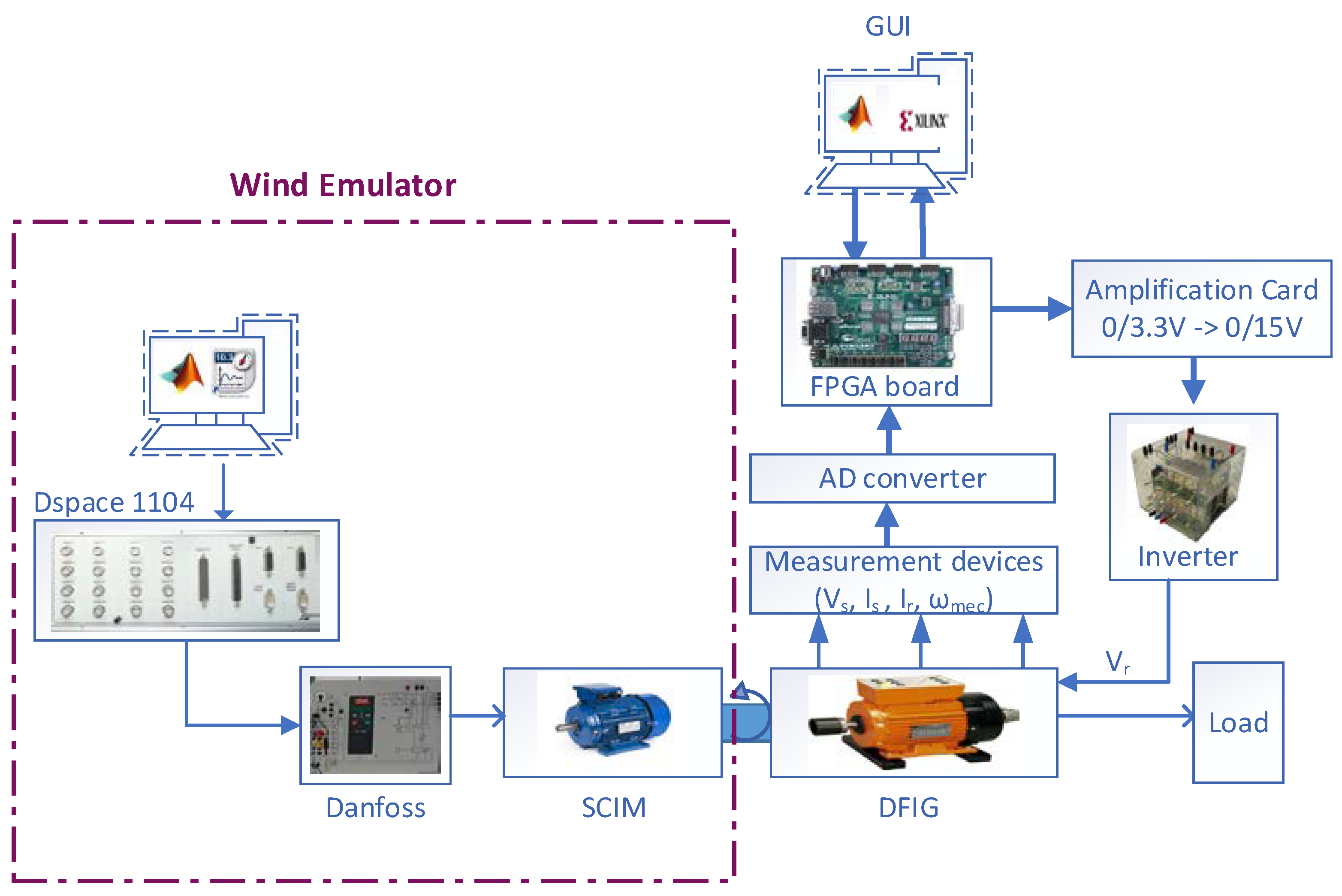
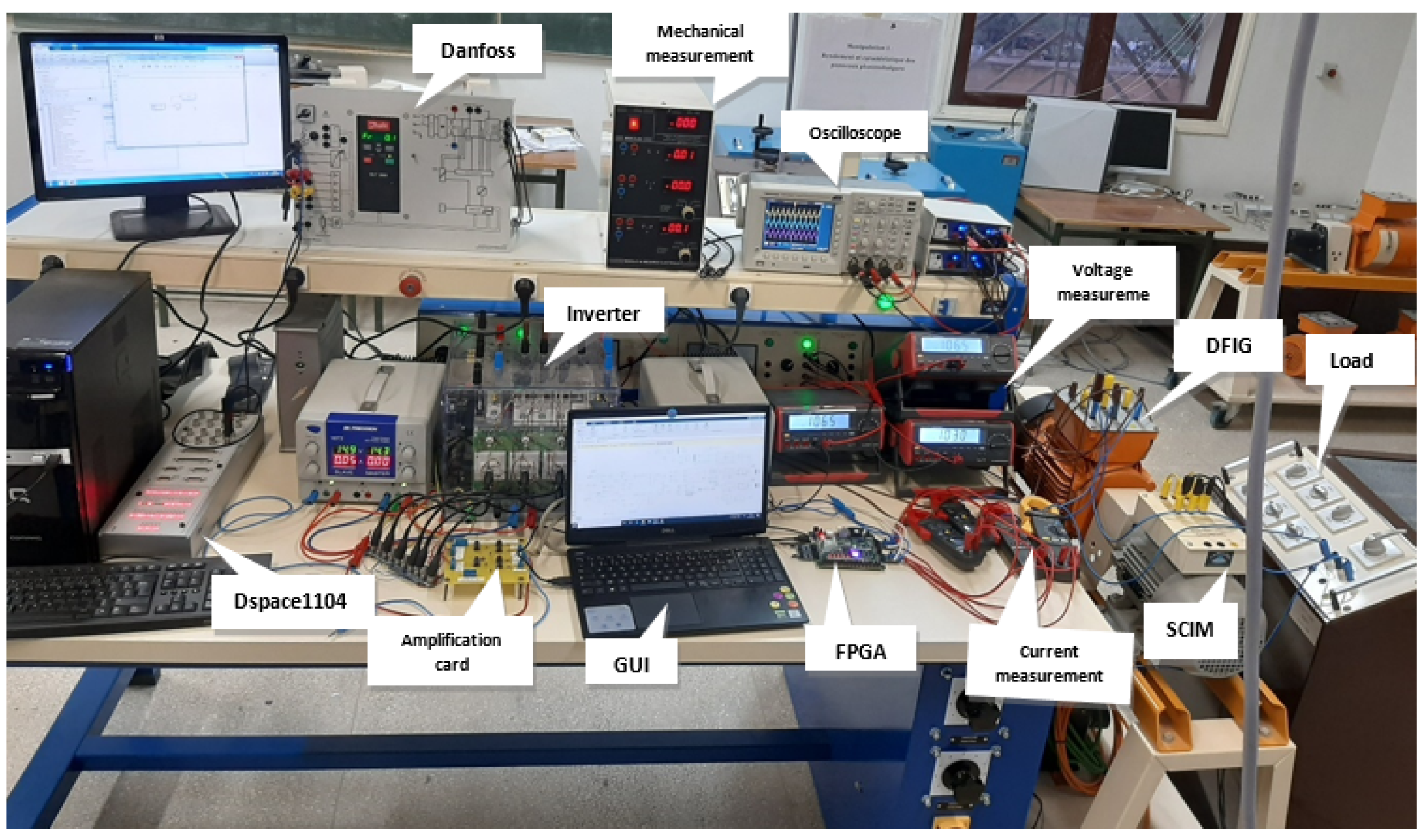
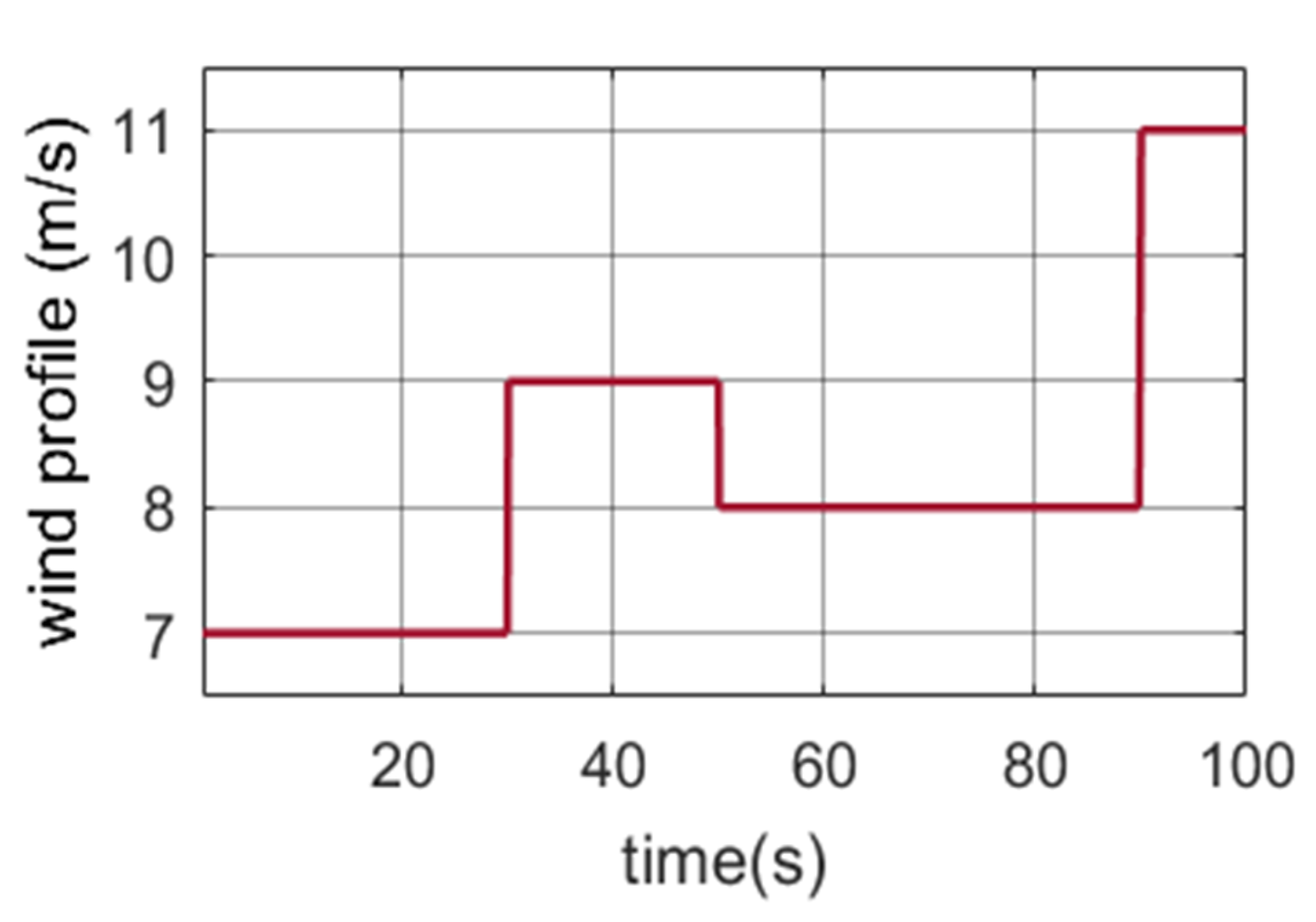
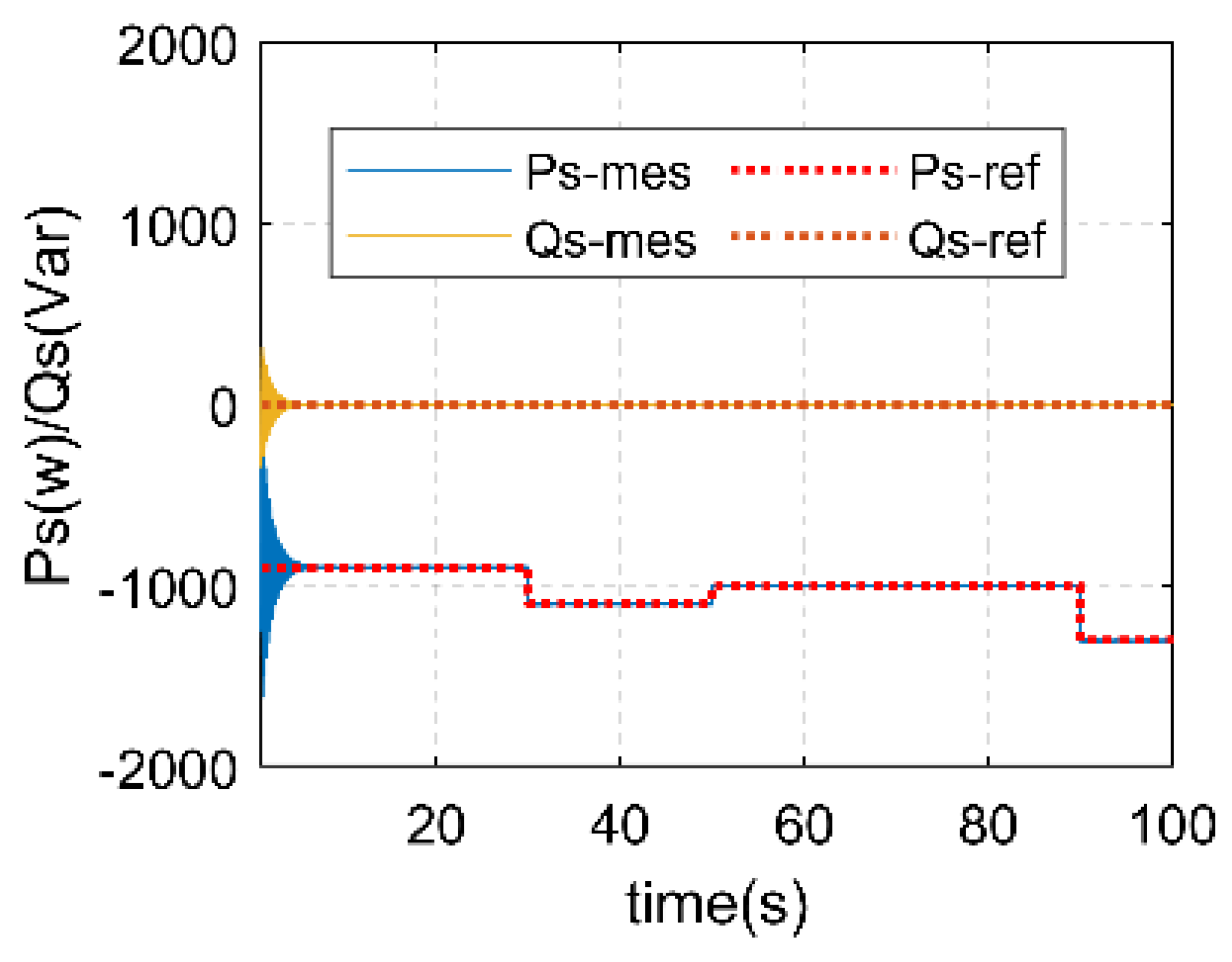
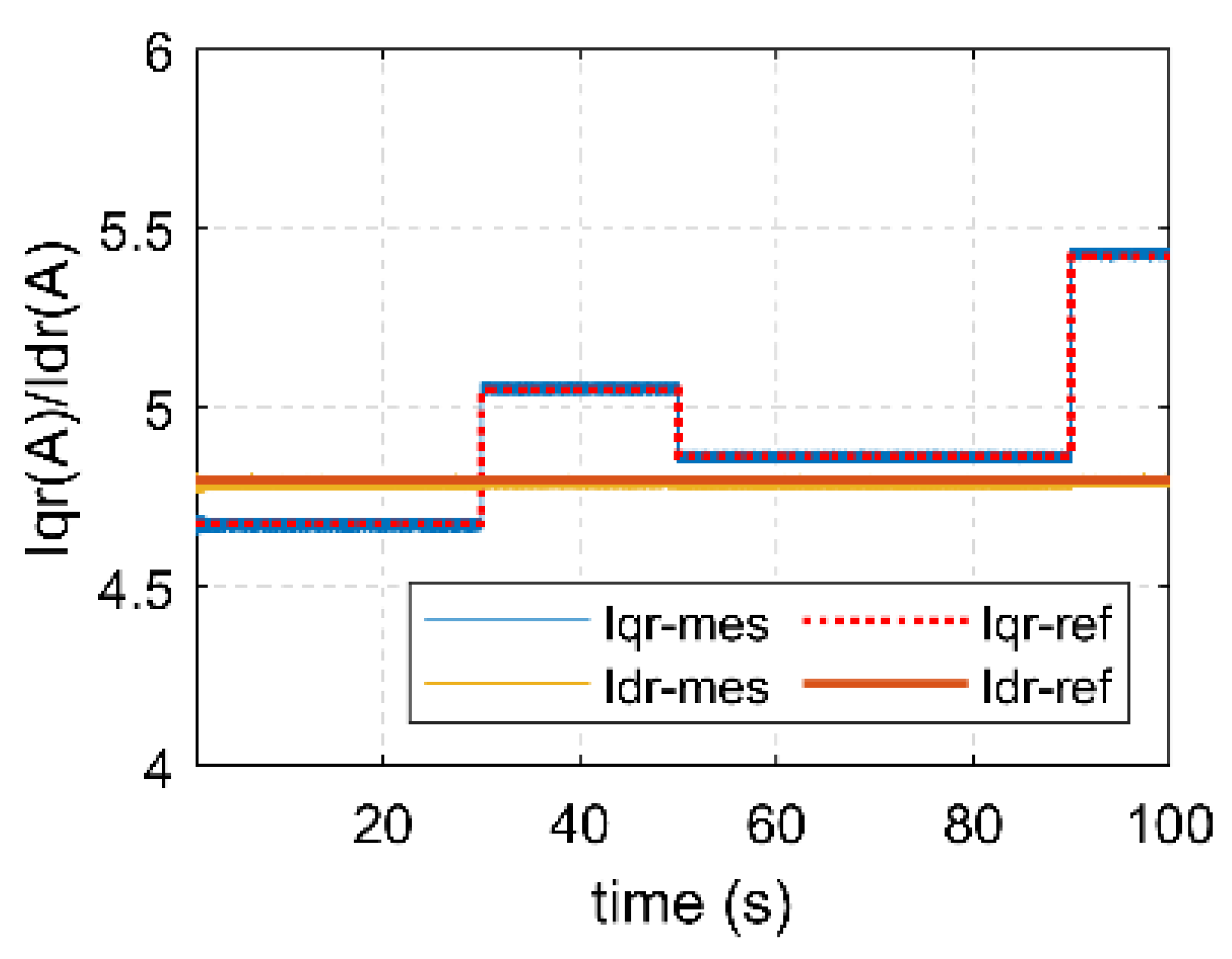

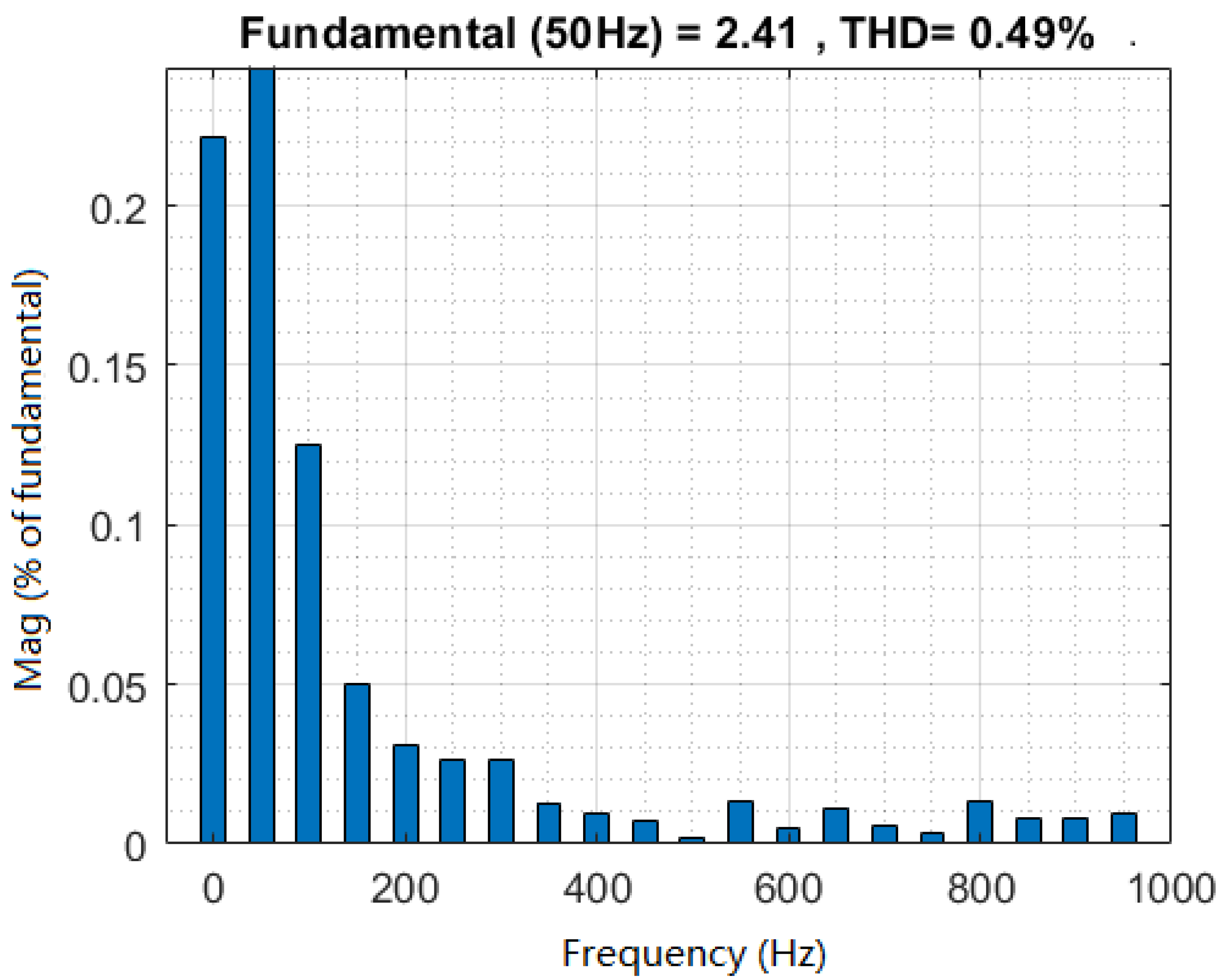

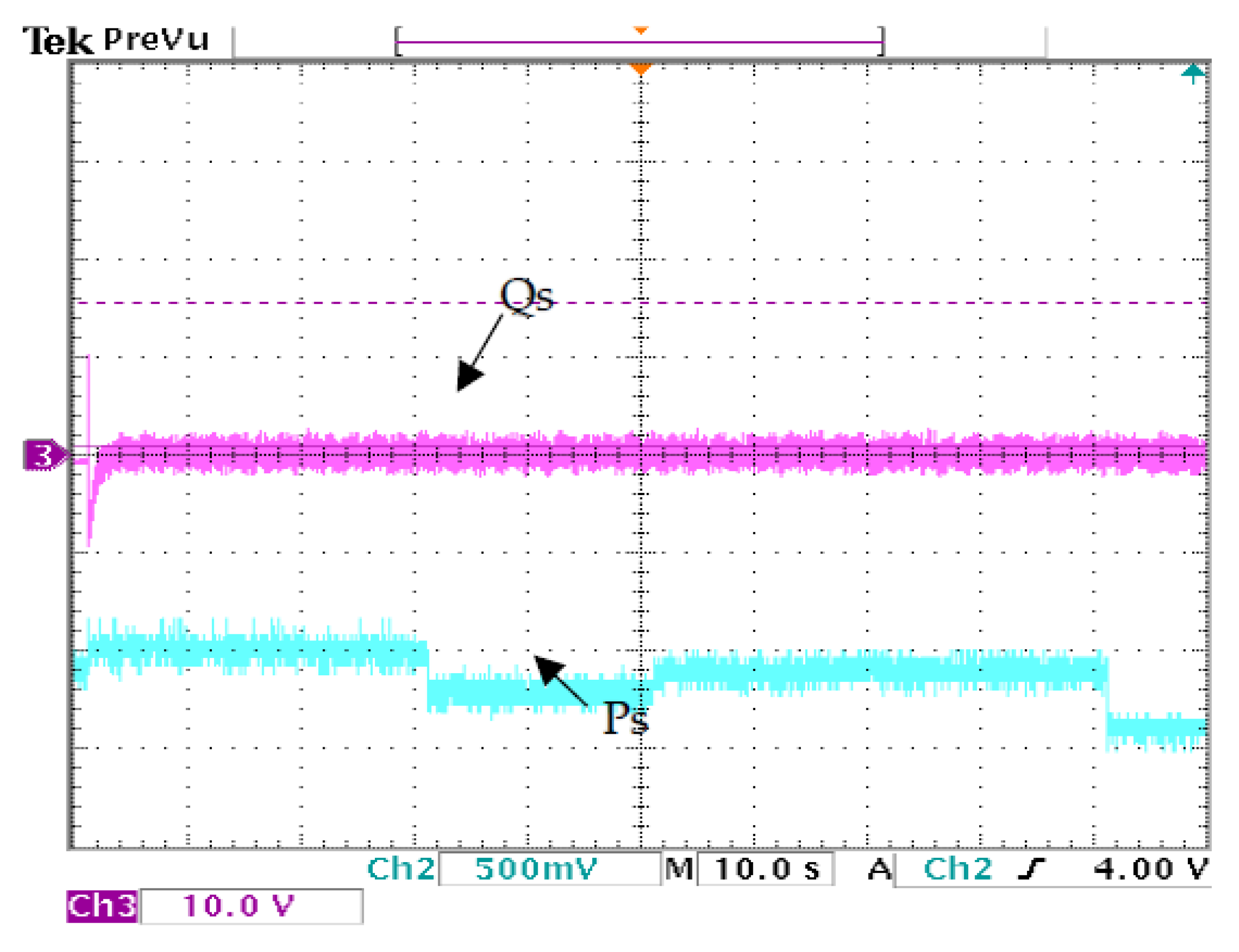
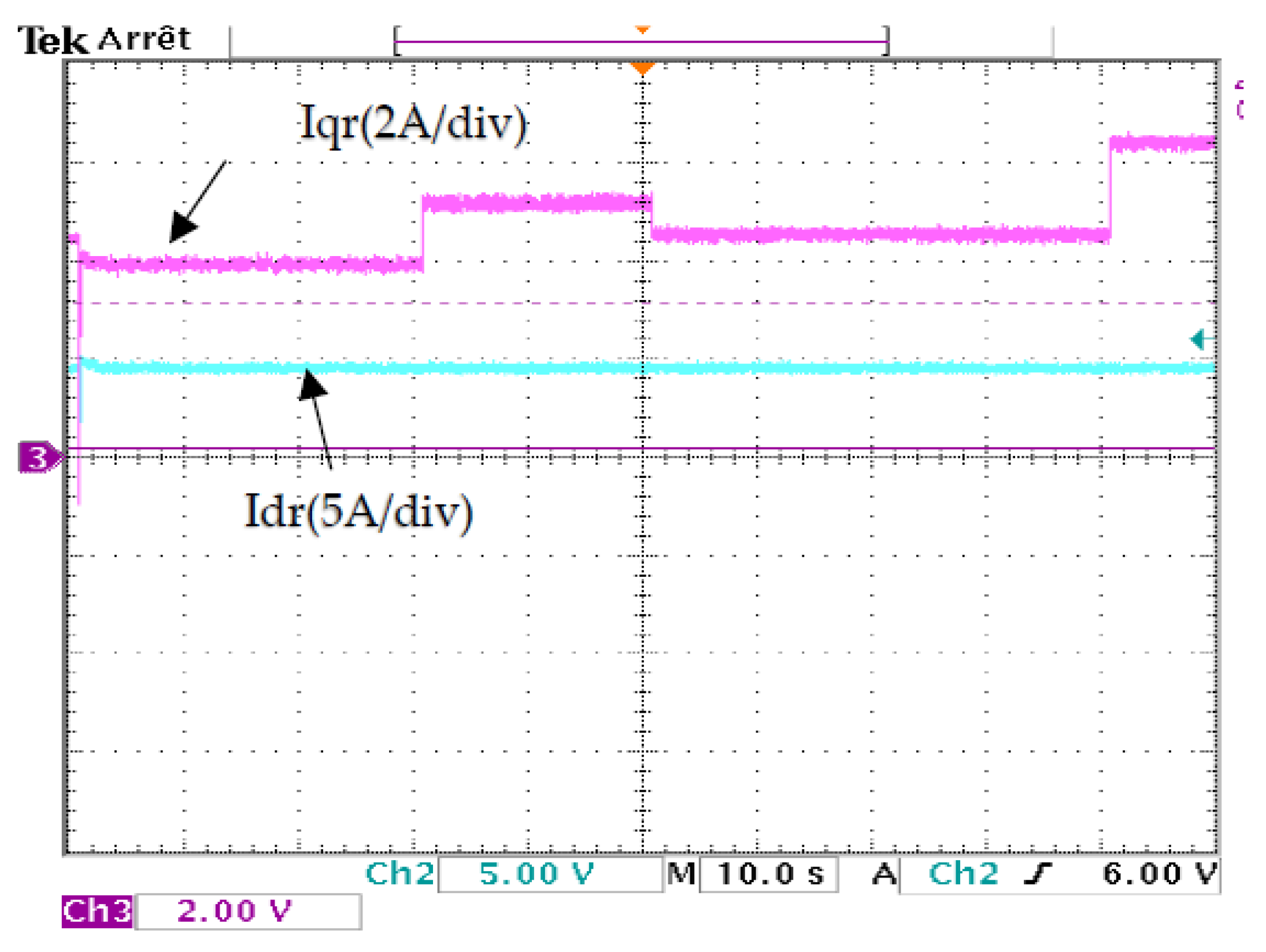

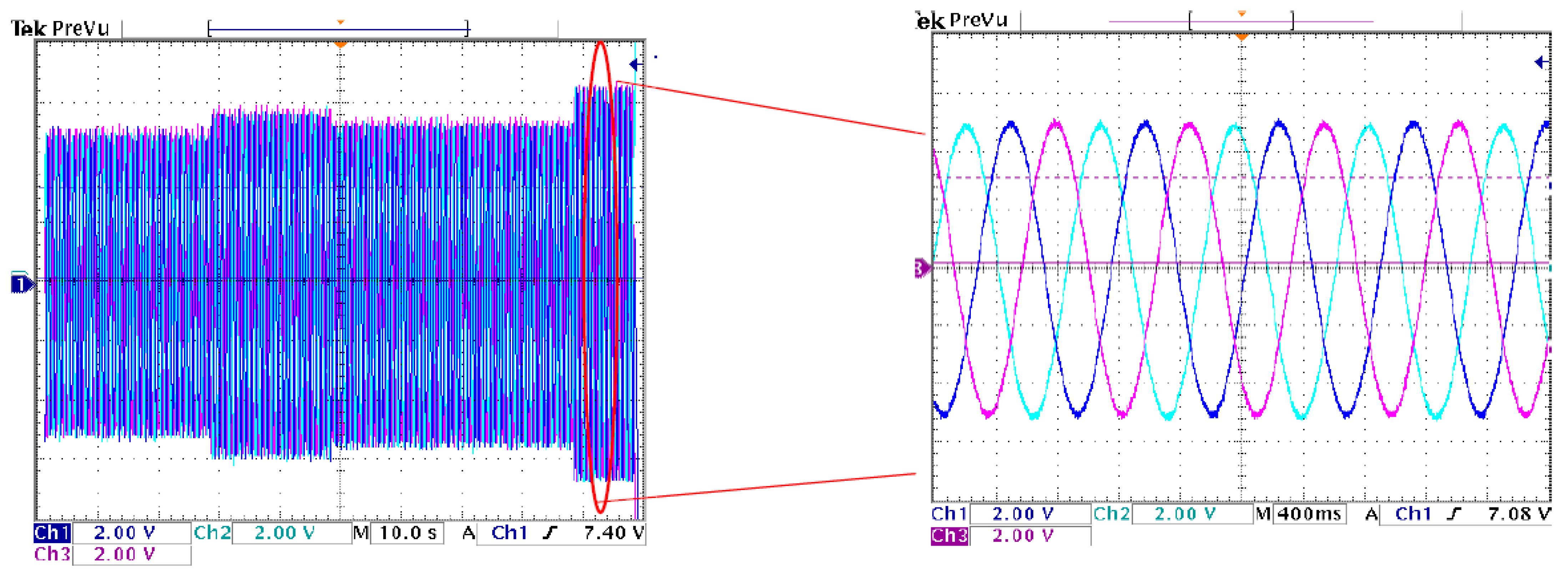
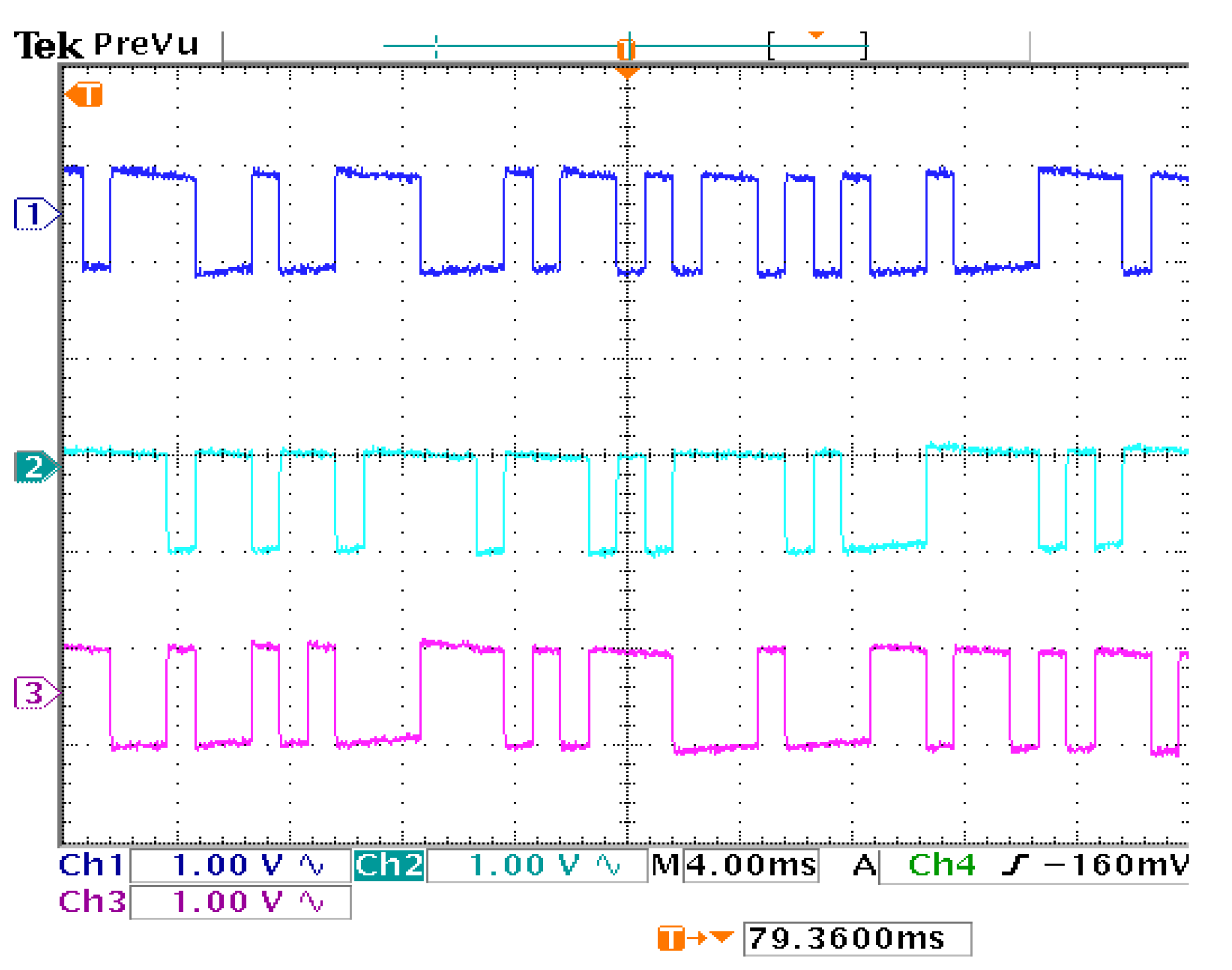

Publisher’s Note: MDPI stays neutral with regard to jurisdictional claims in published maps and institutional affiliations. |
© 2021 by the authors. Licensee MDPI, Basel, Switzerland. This article is an open access article distributed under the terms and conditions of the Creative Commons Attribution (CC BY) license (https://creativecommons.org/licenses/by/4.0/).
Share and Cite
Bouderbala, M.; Bossoufi, B.; Deblecker, O.; Alami Aroussi, H.; Taoussi, M.; Lagrioui, A.; Motahhir, S.; Masud, M.; Alraddady, F.A. Experimental Validation of Predictive Current Control for DFIG: FPGA Implementation. Electronics 2021, 10, 2670. https://doi.org/10.3390/electronics10212670
Bouderbala M, Bossoufi B, Deblecker O, Alami Aroussi H, Taoussi M, Lagrioui A, Motahhir S, Masud M, Alraddady FA. Experimental Validation of Predictive Current Control for DFIG: FPGA Implementation. Electronics. 2021; 10(21):2670. https://doi.org/10.3390/electronics10212670
Chicago/Turabian StyleBouderbala, Manale, Badre Bossoufi, Olivier Deblecker, Hala Alami Aroussi, Mohammed Taoussi, Ahmed Lagrioui, Saad Motahhir, Mehedi Masud, and Fahad A. Alraddady. 2021. "Experimental Validation of Predictive Current Control for DFIG: FPGA Implementation" Electronics 10, no. 21: 2670. https://doi.org/10.3390/electronics10212670
APA StyleBouderbala, M., Bossoufi, B., Deblecker, O., Alami Aroussi, H., Taoussi, M., Lagrioui, A., Motahhir, S., Masud, M., & Alraddady, F. A. (2021). Experimental Validation of Predictive Current Control for DFIG: FPGA Implementation. Electronics, 10(21), 2670. https://doi.org/10.3390/electronics10212670









